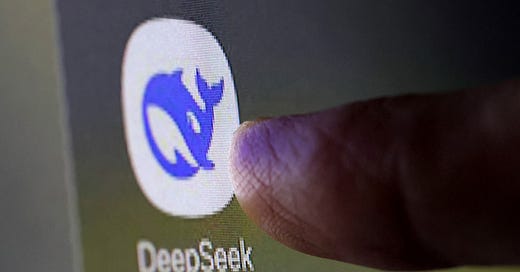The DeepSeek Effect (Part 1)
The new AI war begins for the United States and China, thanks to DeepSeek.
Ahead of Lunar New Year celebrations, international observers were stunned by the release of Chinese artificial intelligence (AI) startup DeepSeek’s new AI model “R1.” The “DeepSeek Effect” rocked markets, bolstering the reputation of China’s AI industry and amplifying nationalist anxieties regarding US-China AI-related competition.
The popularity of DeepSeek’s R1 sent shockwaves through the market, causing the panic sell-off of many American technology stocks in late January, particularly Nvidia – the world’s leading AI chipmaker.
The reason? The remarkably low reported production cost of DeepSeek’s technology, which led many to believe DeepSeek could disrupt the already red-hot AI industry by reducing the entry barrier even lower, and cheaper.
DeepSeek, which was founded in 2023 by Liang Wenfeng, co-founder of the hedge fund High-Flyer, claimed that the GPU-hour cost of its model training came out to just $5.6 million – a fraction of the $100 million to $1 billion typically spent by US companies on developing comparable models.
If DeepSeek’s technology genuinely delivers with low production costs, it could revolutionize the industry’s demand for AI chips, challenge the valuation of high-priced chips used for AI model training, and prompt a reassessment of the “Magnificent 7” AI stocks, including Nvidia, Tesla, Microsoft, and Alphabet. Most importantly, it could signal that China holds a competitive edge over the United States in developing cost-efficient AI models.
However, common sense often dictates that if something seems too good to be true, it likely is, and DeepSeek may be such an example. Respected technology analyst Ben Thompson pointed out in his latest newsletter that the widely touted figure of $5.6 million for training DeepSeek’s AI model only accounted for the final training run, excluding all other costs including building the computational infrastructure and programming.
DeepSeek faces two core issues that could hinder its global business: 1) the cost and accessibility of data processing and 2) content moderation and censorship. DeepSeek has already tried to address the cost of data processing by quietly suspending new user registration outside of Mainland China, limiting access to Chinese users with local mobile phone numbers (country code +86) since it became a global hit. DeepSeek occupied the top of Apple’s US App Store in late January, becoming the most downloaded free app, exemplifying this growing influence.
DeepSeek is also reportedly seeking a new round of funding to provide more supports for its massive demand for data processing.
Additionally, the company may face scrutiny from regulatory agencies, particularly the Cybersecurity Administration of China (CAC), which noticed some global users began to “abuse” (in CAC’s language) the DeepSeek model by asking politically sensitive questions such as, “How would DeepSeek rate President Xi Jinping’s performance” and “Do you know what happened on June 4, 1989 on the Tiananmen Square?” In one case, when DeepSeek was asked about the origin of the Covid-19 pandemic, it replied, “I cannot answer this question. Let’s try to talk about something else.”
Despite such shortcomings, many users who tested DeepSeek agreed that its responses were significantly better than earlier models released by larger domestic competitors like Alibaba, Baidu, and Huawei. Still, DeepSeek’s unavoidable content censorship, dictated by China’s regulatory environment, could diminish its appeal and accuracy for some global users over time.
The recent attention paid to DeepSeek is also raising alarm bells within the Trump Administration about China’s progress in AI technologies. On January 27, President Donald J. Trump commented that “the release of DeepSeek AI from a Chinese company should be a wake-up call for our industries that we need to be laser-focused on competing.”
As DeepSeek captures Trump’s attention, it could prompt the US Administration to accelerate or intensify its technology denial strategy, which could pose a challenge for DeepSeek, as its models rely on Nvidia chips. This underscores the pivotal role that Nvidia and its founder, Jensen Huang, play in shaping the global AI landscape.
Critics outside government, meanwhile, said that the DeepSeek episode points to the ultimate futility of the United States trying to use hardware controls to constrain China’s AI software progress.
Looking ahead, it is likely that China will develop several leading AI models optimized for the Chinese language, while US AI models like OpenAI and Google’s Gemini will remain inaccessible in China. This situation mirrors the familiar one where Chinese users are unable to access Google, and the domestic search engine Baidu serves as a viable alternative.
Ultimately, the AI race may not have a clear winner. For now, China and the United States may be “running different races,” with China aiming for cheaper commercialization and expertise in AI interference, leading to the ability to engineer AI applications efficiently, while the US is seeking to lead in cutting-edge AI innovation using advanced chips.
(Author’s note: Please continue to read Part 2 of my analysis on the “DeepSeek Effect” as I try to explain other “effects” beyond the technical aspect.)




